Music is the universal language
“Glory to God in the highest heaven, and on earth peace to those on whom his favor rests.” - Luke 2:14
Norse Guitar Feeds
NS Design Unveils New Carbon Fiber Fin Guitar and Bass
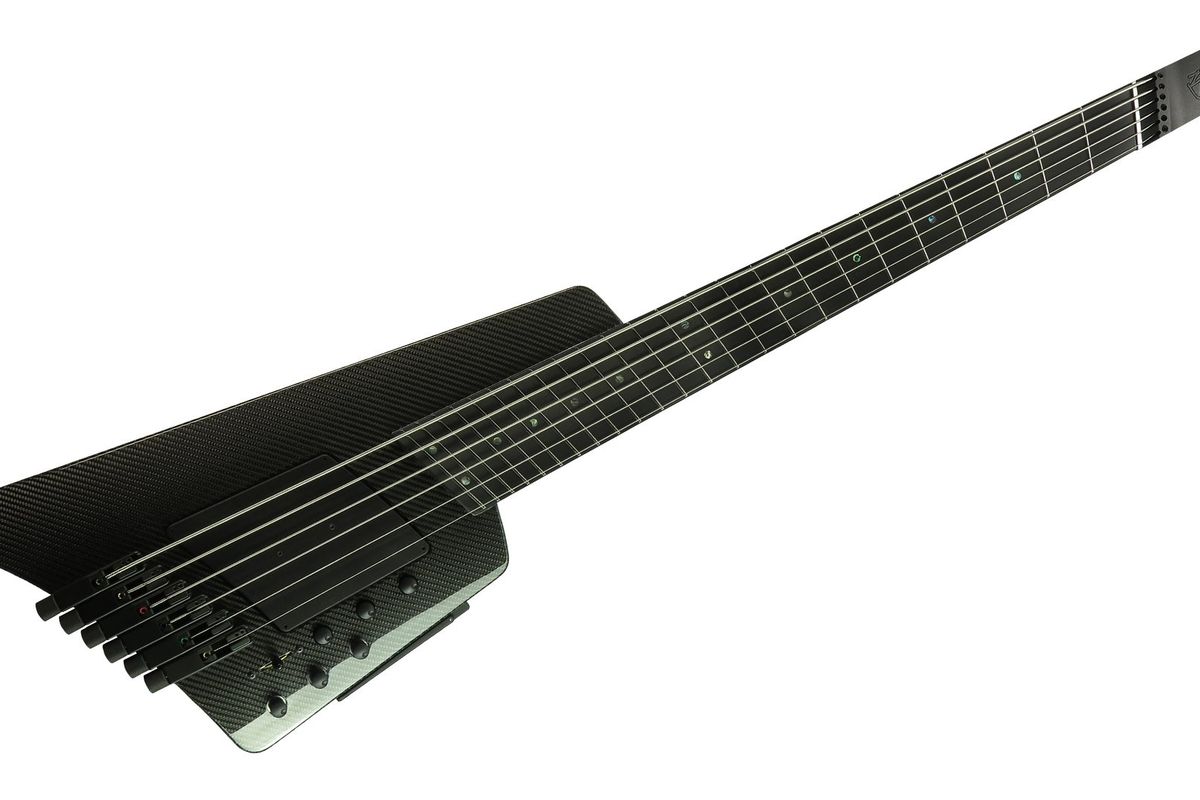
Ned Steinberger, inventor of the headless bass, has unveiled his new NS Design Fin guitar and bass at the Mannheim Guitar Summit in Germany. These multiscale instruments are available in 6-string configurations and combine cutting-edge carbon fiber construction with innovative electronics to deliver unparalleled sonic performance for the modern musician.
Key features of the NS Fin Guitar and Bass include:
- All-carbon fiber construction for extended sustain, brilliant harmonics, and bold low-end response.
- Lightweight ergonomic design - Guitar weighs just 5½ lbs., bass only 8 lbs., with perfect balance.
- Modular pickup configuration allows any combination of humbucking and single-coil pickups.
- Revolutionary Activator™ circuit by Mi-Si™ with supercapacitor power and up to 12dB boost.
- Fulcrum™ tuning system features a patented self-clamping mechanism for quick string changes.
- The scale length ranges for the guitar and bass - Guitar: low E string 26 inches, high E string 25 inches. Bass: low E string 35.3 inches, high C string 32.7 inches.
- Multiscale fretboard provides optimized string tension and intonation for enhanced playability.
NS Design’s Fin Guitar is priced at $8,500 USD, and the Fin Bass is priced at $9,500 USD. They are available in a limited-edition run of 12 each, made in USA from 100% carbon fiber. For more information visit thinkns.com.
PRS SE NF 53 Review
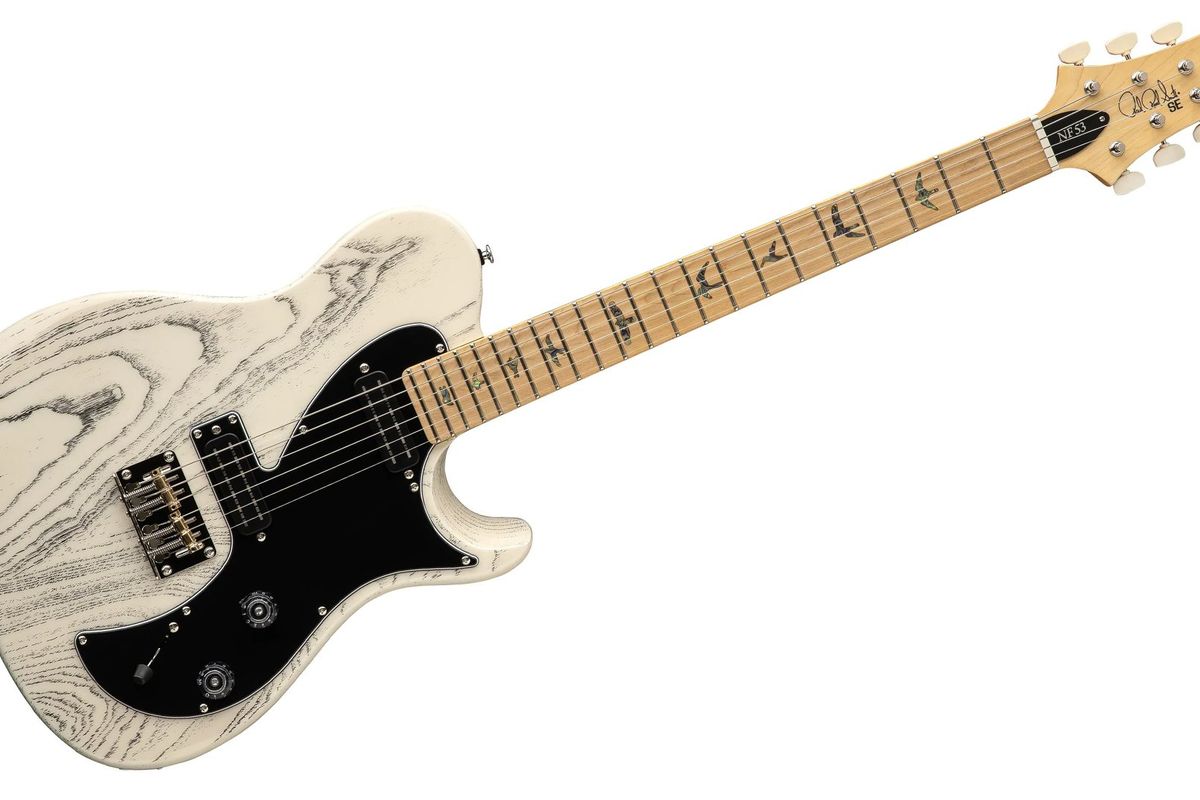
Like the Silver Sky, the NF 53 revealed Paul Reed Smith’s deep reverence for classic Fullerton designs and curiosity about how to expand on those templates. 2023’s NF 53 release left us impressed, and it was only a matter of time until an offshore-built SE model followed. That time has come: The SE NF 53 is here, dressed in the same lines and livery as the USA-built model, but at a more affordable price point thanks to PRS-licensed and supervised manufacturing by the Cor-Tek Musical Instrument Co. in Indonesia.
Like the NF 53, the SE model is more a riff on the Telecaster theme than a copy. Unburdened by tradition, PRS carved away at every line of the single-cutaway form, and the electronics are very much about enhancing versatility, rather than reducing componentry to the absolute basics. Even so, the SE NF 53 still drips with Tele-ness.
Single-Cut Minded
T-style traditionalists will find much that feels familiar, like the 25.5" scale length and bolt-on maple neck. From there, though, the SE NF 53 deviates from vintage T-style spec pretty quickly. There are 22 medium-jumbo frets, and the neck is constructed with a scarf joint that increases strength at the headstock break. The maple fretboard is sliced away from the neck and reglued after installation of the truss rod. Its width at the nut falls between Gibson and Fender camps at 1 41/64". The 10" radius also splits the difference between vintage Gibson and Fender specs, and it all feels great in hand courtesy of a rounded-C profile that measures about .87" deep at the first fret. The guitar’s overall weight is around 8.1 lbs.
In Telecaster style, the SE NF 53’s body is made from swamp ash—in this case, using 3-piece construction. It features belly and forearm contours, and a contoured cutaway for easier upper-fret access. PRS maximized the drama of the ash’s distinctive grain with a white doghair finish on our review sample, and black grain filler makes the wide, rippling lines pop and weave beneath the white. They reverse the effect entirely on the black doghair version, and hide the grain entirely on the pearl white finish.
In the hardware department, the SE NF 53’s bridge nods to a vintage Telecaster’s brass barrel saddles, but it uses a steel-base design with string-anchor notches rather than through-body stringing. It also deviates from T-style tradition by assigning three strings to a saddle with two adjustment bolts, rather than three saddles with two strings each.
Like the USA model before it, the SE NF 53 is fitted with a pair of PRS’s Narrowfield DD pickups, although these are the “S” variant, which are designed to enhance low-end tones while retaining snarl and twang. The “DD” stands for deep dish, meaning these single-coil-sized humbuckers are made with deep bobbins to enable extra coil windings, using a mix of magnet pole pieces with steel poles in between. They are wired through master volume and tone controls and a three-way selector switch on a plate that nods toward the late ’60s Fender Telecaster Thinline.
Taken together, the SE NF 53 is a cohesive design, made stronger by its robust build quality. There’s no real lack of refinement in evidence when compared to the USA model. Some of the woods and components are a different grade, but the overall result is a guitar that lends a sense of confidence.
Field Day
Plugged into a Fender Bassman head and 2x12 cab, a Vox AC15 1x12 combo, and a Fractal FM9 into headphones, the guitar reveals a genuine alternative to the T-style formula suggested by its components. Its character is distinctly its own—and with noticeably less hum.
The Narrowfield DD “S” pickups play a big part in the guitar’s success. The easiest reference point I can think of might be a blend of Telecaster and P-90 tonalities, but with plenty of their own thing going on. With a clean amp or setting there’s a meaty growl on top of the twang. Yet the guitar isn’t short on bright, sparkly chime, and sounds alive in those frequencies without being strident or spikey. This sonic foundation puts edge-of-breakup tones right in the SE NF 53’s wheelhouse, where the chewy bite segues into a little bit of breakup when you hit it hard. And it’s just as comfortable with high-gain tones, where the same sonic characteristics that contribute sweetness in cleaner settings enable clarity and cutting power while avoiding harshness in the highs. In fact, the guitar is at home in so many settings, sharing a Telecaster’s versatility and its effortless ability to handle almost anything with style.
The Verdict
The NF 53 platform is a very likeable tribute to the seminal T-style without trying to replicate it and, as a result, it’s versatile and inspiring guitar in its own right and in its way. And in the SE version of this design it delivers at a price that belies its vocabulary and its confidence.
Ace Frehley cancels show following fall in his home studio

Founding Kiss guitarist Ace Frehley has cancelled his upcoming show at the Antelope Valley Fair in Lancaster, California after suffering a fall in his home studio.
In a statement posted yesterday (25 September) on his social media channels, Frehley’s team offered more detail about the incident.
“Ace had a minor fall in his studio, resulting in a trip to the hospital,” the statement reads. “He is fine, but against his wishes, his doctor insists that he refrain from travel at this time. As a result, he is forced to cancel his performance at the Antelope Valley Fair on Friday, 26 September.
“Please go to the fair to support his friends in Quiet Riot and Vixen, and Ace looks forward to continuing on his tour and finishing work on his next album, Origins Vol. 4.
Despite the statement, the 74-year-old guitarist has yet to release the third installment of his Origins album series, following Origins Vol. 2 in 2020.
Earlier this year, Frehley told Eddie Trunk that Vol. 3 was in the process of being recorded with producer Alex Salzman, who also worked on the first two installments.
“We have a formula that we came up with and it seems to work,” he said [via Blabbermouth]. “I was listening to the records last night on YouTube, you know. In my office, on my desk, I have a set of Bose speakers, and the album sounds just as good as the new album, 10,000 Volts [which landed in 2024]. So I’m gonna keep that.”
“I’m gonna go back to my old formula with Alex and maybe I’ll bring back Steve [Brown, Trixter guitarist who also worked on 10,000 Volts] to do the studio album since he’s a very, very good songwriter and guitar player and engineer, as well.”
In other news, Frehley recently detailed how he declined an invitation to appear at the Kiss Kruise: Land-Locked in Vegas event. “They asked me and I declined. There’s no way I’m gonna be involved in that,” he said.
The post Ace Frehley cancels show following fall in his home studio appeared first on Guitar.com | All Things Guitar.
Brian May admits he still finds it hard to play Queen’s Bohemian Rhapsody: “I still have to keep my wits about me or I’ll fall off the train”

You’d think after half a century of playing one of the most famous songs in rock history, Brian May would have it down cold. But according to the Queen guitarist, Bohemian Rhapsody remains as tricky as ever – so much so that he still has to ‘keep his wits about him’ every time he plays it.
Speaking to Rolling Stone, May shares how the complexity of Freddie Mercury’s writing made the track both exhilarating and challenging to play.
“The idea for all the instrumental stuff in Rhapsody was growing while I was listening to him developing the song,” he says. “Freddie had some amazingly lateral thought processes. It was always easier for me to play on his songs than mine, ’cause there was so much stimulation coming.”
That said, the six-minute track is no walk in the park, even for its original guitarist.
“Bohemian Rhapsody is never that easy to play, even after all these years,” May admits. “I still have to keep my wits about me or I’ll fall off the train.”
And while the song continues to test him, the grind of constant touring is another challenge altogether. Though fans may be clamouring for yet another Queen tour, May, now 78, admits that life on the road no longer holds the same appeal.
“ I’ve had 50 years of touring and there’s a part of me that thinks it’s enough,” he says. “I don’t like the idea that you wake up in your hotel room and you’re trapped. I had a few experiences recently where stuff happened at home with my family and I could not go home. It got under my skin and I just thought, ‘I’m not sure if I want this anymore.’ I feel like I’ve given up my freedom too many times. So my feeling at the moment is I don’t want to tour as such. I still want to play shows. I still want to innovate.”
That innovation may soon find a new home in Las Vegas. May has his sights set on a Queen residency at the Sphere, the high-tech venue with 360-degree visuals that left him stunned after watching the Eagles perform there.
“ I’m very keen on the Sphere,” says the guitarist. “It’s got my mind working. I sat there watching the Eagles, thinking, ‘We should do this. The stuff that we could bring to this would be stupendous.’ So, yeah, I would like to do it. We’re having conversations.”
The post Brian May admits he still finds it hard to play Queen’s Bohemian Rhapsody: “I still have to keep my wits about me or I’ll fall off the train” appeared first on Guitar.com | All Things Guitar.
“Why would I want to do it the same?”: Why David Gilmour “never learned” this classic Pink Floyd guitar solo

Few guitar solos are as universally revered as the climactic second solo in Comfortably Numb. It’s the soaring, heart-wrenching finale to one of Pink Floyd’s most enduring songs, and the kind of performance many guitarists have spent decades trying to replicate. Yet the man who wrote it – prog wizard David Gilmour – admits he’s never actually learned it when it comes to playing live.
Speaking with Rick Beato in a recent interview, the Floyd guitarist explains that the solo, while immortalised on The Wall, has never been something he felt the need to reproduce exactly.
“I’m not thinking about the audience and what they want, to be honest,” he explains. “I just like it starting the way it starts, and the rest of it is so ingrained in me that the various parts of it are going to find their way into what I’m doing.”
“But I’ve never learned it. Yeah, I’ve never learned that guitar solo.”
For Gilmour, the live experience is about feeling the moment rather than sticking to a routine formula: “I mean, there are a lot of guys who can play that. But I don’t play it,” he laughs.
“To me it’s just different every time. Why would I want to do it the same? Would it be more popular with the people listening if I did it exactly like the record? Or do they prefer that I just wander off into whatever feels like the right thing at the time? I don’t know. I suspect they prefer it to be real, and to be happening, you know?”
Still, his improvisational spirit doesn’t mean he’s completely unmoored from the studio version.
“There are cues within it, which I use to tell the band, ‘We’re going to end,’ or, ‘We’re going to do this,’” says Gilmour. “And so, they crop up as being the same every time, pretty much.”
The post “Why would I want to do it the same?”: Why David Gilmour “never learned” this classic Pink Floyd guitar solo appeared first on Guitar.com | All Things Guitar.
New EarthQuaker Devices Fuzz Pedal
Fender Player II Modified Telecaster – “this guitar just begs to be played for hours”

$1049.99/£949, fender.com
When Fender launched the Player II series last year, it felt like a significant leap forward in the quality and especially playability of the brand’s most affordable Mexico-made instruments.
Fender’s Ensenada factory guitars have also proved to be great modding platforms for pros and weekend warriors alike for decades now, and so it is that less than a year later, the Player II Modified range has sought to do the hard work for you.
Whether it’s Noiseless pickup-loaded Strats or Floyd Rose HSS offerings, the results have been pretty impressive so far – but can they say the same for Leo Fender’s original brilliant electric guitar design? Let’s find out…
 Image: Adam Gasson
Image: Adam Gasson
Fender Player II Modified Telecaster – what is it?
The original Player II Telecaster was a very impressive guitar as it is. And many of the original’s best features are kept for the Modified version – that means an alder body and maple neck with rosewood fingerboard, and yes those ‘board edges are nicely rolled just like the original. That neck is the same 9.5-inch radius’d C-shape as the Player II too.
Another holdover on this test example is a three-colour sunburst finish, but unlike the vanilla Player II it’s accented rather nicely with a four-ply white pearloid pickguard to make it stand out from the rabble.
Under the hood, there’s a lot more going on, however. Most notably, you get a pair of Fender’s Player II Noiseless Tele units – which should come in handy for noisy environments – and more advanced wiring nestling in that body cavity.
In practice that means you get the ability to switch between series and parallel wiring, and there’s also a treble bleed circuit on the volume control to keep things clear and focused as you roll off.
You also get a set of Fender’s locking tuners to make string changes a doddle, while a soft-shell gigbag is included in the price here too – something that was notably absent from the basic Player II range.
 Image: Adam Gasson
Image: Adam Gasson
Fender Player II Modified Telecaster – feel and sounds
One of the chief concerns one might have when buying a conventional Telecaster, or any guitar with only single coils – at least if you are slightly more hard rock-inclined – is that the absence of a humbucker might prove inhibitive.
But thanks to the Player II Modified Telecaster’s push-pull tone pot-activated series mode – which utilises both the neck and bridge pickup at once in series – a sound is included in your palette which very effectively fills that humbucker void.
I’d class myself as a ‘recently country-curious’ player who primarily comes from a hard rock and metal background. With this in mind it’s a very pleasant surprise when I almost automatically dial in a high-gain tone and jam some quickfire palm-muted chugs in series mode.
Look, if you’re looking to venture into extreme metal territory you’re not going to find your perfect match here, but Player II Modified Tele definitely holds its own with heavier sounds with both pickups engaged – no doubt in part due to the Noiseless nature of the design. There’s a reason why Idles were involved in the marketing campaign for these instruments.
 Image: Adam Gasson
Image: Adam Gasson
Fun side note, though: there’s a space between the series-on and series-off settings on the push-pull tone knob where signal is cut entirely, so the more creative among you might be able to use it as a makeshift killswitch and channel your inner Tom Morello.
Moving into the sort of tones that you’d probably expect this guitar to handle, here the pickups show their versatility and their quality – with the Noiseless factor adding real punch and clarity to blues, country and rock licks.
The bridge pickup boasts that classic Tele twang, while the neck pickup has a gloriously warm tone, while retaining a level of articulation by which the guitar just begs to be played for hours.
The treble bleed circuit is another really useful extra tool to have in your arsenal when you’re indulging in grittier tones. The ability to roll off the volume and clean things up without losing clarity adds another string to this versatile instrument’s bow.
If there’s one slight bugbear I have with the guitar straight out of the box, it’s that the action is a little high to really get the most out of the playability. It’s a relatively easy fix that any half-decent tech can handle if you’re not confident with doing it yourself of course, but it’s still suboptimal.
Otherwise, the general fit and finish of everything is truly top class – there are zero noticeable visual hiccups or sloppiness. The neck itself is effortlessly smooth, with those rolled edges really enhancing things again, and it really does feel every bit the road-ready pro instrument.
 Image: Adam Gasson
Image: Adam Gasson
Fender Player II Modified Telecaster – should I buy one?
Fender has expended a fair bit of energy catering to their ‘pro’ market in the shape of the American Ultra II and Ultra Luxe guitars, but those instruments are also priced at a level that many ordinary working musicians can’t really consider.
So for that reason alone, it’s great then that the Player II Modified exists. The standard Player II Telecaster will be plenty of instrument for many players, but if your needs are a little more unconventional and you venture into the heavier spectrum of sounds, this Modified version will be right up your street.
Fender Player II Modified Telecaster – alternatives
You could, of course, go for a non-modified, standard Player II Telecaster (from $839.99/£709) if you’re not overly fussed about the series mode, treble bleed circuit or locking tuners. The previous iteration of the Modified concept was the Player Plus range, and you can still find them kicking around with a healthy discount – they’ll also give you Noiseless pickups and those lovely rolled fingerboard edges.
The post Fender Player II Modified Telecaster – “this guitar just begs to be played for hours” appeared first on Guitar.com | All Things Guitar.
Pedalmania! Keeley, Mr. Black, Hotone, and NUX Demos
As the leaves change and the holiday season approaches, PG contributor Tom Butwin highlights standout pedals from the bevy of tone machines that graced shelves this year. In his first installment of Pedalmania, hear demos of the flexible Keeley Manis Overdrive, Mr. Black's DoubleTracker Stereo, the spacey new Hotone Verbera convolution reverb, and the featured-packed NUX Amp Academy Stomp.
Review: Buck Curran’s ‘Far Driven Sun’ Reunites a Beloved Sobell Guitar with a Master of Acoustic Atmosphere
Remembering Tony Rice: 8 Iconic Licks from the Master Guitarist

In December of last year, Tony Rice passed away. He was/is my all-time favorite guitarist. Like many of his fans, my love of his playing has likely transcended obsession. In fact, at the time of writing this, I have transcribed over 100 Tony Rice solos. That puts me in a unique position to share with you not only my favorite Tony Rice licks but what I think might be Rice's favorite licks, if the frequency with which he played them is any indication.
These examples can be found in almost every Tony Rice break. They are integral to his sound and they can become part of your sound too. This comes with one small warning though: These licks are not meant to be parroted off this page. A big hallmark of this sound is to use these phrases but to vary them, and create your own versions of them. Let's remember Rice by innovating on his past achievements the same way he innovated on the achievements of the players that came before him.
How to End a Bluegrass Song
One of the most famous and enduring Tony Rice licks is this signature tag. A tag is a common way to end a bluegrass fiddle tune or vocal song, the most generic tag being the ubiquitous "shave and a haircut." In Ex.1, you can see what's called a "double" tag. The first tag ends on beat 3 of measure two, before the open 3rd string on beat 3. The remainder of the lick forms the second tag, which eventually morphs into a variation of the Lester Flatt "G run."
Rice's note choice is predominantly major pentatonic but includes an occasional b3 that always resolve down to the 2 or up to the 3. As I say to my students, "Blue notes need buddies." Playing these pairs of notes with articulations like slides and pull-offs that cross bar lines is an important part of Rice's style.
Tony Rice Ex. 1
Use Your Chords
If you're familiar with triads on the D, G, and B strings, you can turn those into bluegrass licks as well. Rice has used the triads in Ex. 2 in a handful of different and interesting ways. He's used the last two chord shapes to form the main riff for "Me and My Guitar," and employed those same shapes to punctuate the end of his "Cold on the Shoulder" kick-off. Sometimes you can see him expand this idea by using even more chord shapes to descend the neck. He would use something like Ex. 2 in a G major context but would be heavily implying G Mixolydian mode by using the F major and D minor triads.
Tony Rice Ex. 2
That One Lick
I've seen this passage referred to multiple times as "that one Tony Rice lick." He uses variations of this passage to finish breaks in "Your Love Is Like a Flower," "Ain't Nobody Gonna Miss Me When I'm Gone," and "Gold Rush." It serves the function of a statement piece to assert his personal voice on the instrument before handing off the spotlight to the next instrumental break or verse of a song with vocals.
As you play Ex. 3 be mindful of how you use your pinky. Every note on the 10th fret is played with the pinky, including a brief pinky barre on the 10th fret of the 3rd and 4th strings.
Tony Rice Ex. 3
Pull-Off Central
This lick has been featured in recordings, but I associate it much more with Rice's live sound. Whenever Rice needs a second to think about what to play next, Ex. 4 seems to come to his fingers first. The note choice here lands firmly in the minor pentatonic camp but he manages to create a little bit of an outside sound with the third iteration of the pattern that brings in the b5 at the 6th fret of the G string.
Tony Rice Ex. 4
Escape Notes
Have you ever been stuck up the neck improvising with no idea how to get back down to something more familiar? Me too! So, let me introduce you to escape notes. Sometimes you can find an open string that will continue your line in a linear fashion while freeing up your hand to shift down the neck. Take a look at the F, E, and D eighth-notes in the first measure of Ex. 5. Rather than playing those three notes in position, Rice is using the open 1st string so he has time to shift his hand while continuing his eighth-note line.
There are examples of Rice using variations of licks like this in "Blue Railroad Train," "A Hundred Years from Now," and "Likes of Me." You can use this in a D major context or in a G major context over a D chord.
Tony Rice Ex. 5
Acoustic Bends
It can be done, and in a situation like this we're not necessarily shooting for something perfectly in tune. In Ex. 6 you can see that pulling down on the 4th string at the 3rd fret will bring the note closer to F#, the 3 of the chord, but in practice Rice usually doesn't get all the way there.
Tony Rice Ex. 6
Phrasing
If you asked a random flatpicker at a bluegrass festival to play a Tony Rice lick, they would probably play something like Ex. 7. These types of phrases have endless variations and demonstrate Rice's long-standing influence on bluegrass music. These licks are built from a G minor pentatonic (G–Bb–C–D–F) bone structure but always feature a pull-off from the 2nd fret to the 1st fret on the B string and a slide from 3rd to 4th fret on the G string. This pull-off and slide are great reminders that blue notes need buddies.
Tony Rice Ex. 7
True Minor
Bluegrass isn't all major tunes though. There are standards in minor keys. We're talking about tunes that are actually minor—not just playing minor pentatonic licks over major chords. With that in mind, it would be wrong of me to not mention Ex. 8, one of Rice's favorite improvisational ideas to employ over minor tunes. This kind of lick is all over Rice's original compositions in minor keys and the recordings he made with David Grisman. The idea is framed in a slightly ambiguous way, so you can find Rice using it in A minor and D minor.
Tony Rice Ex. 8
It's an impossible task to completely distill Tony Rice's playing into a single lesson. I would point you to nearly any album in his discography to get the essence of modern bluegrass guitar right from the source. His touch, feel, tone, and vibe forever changed acoustic music and we all will be eternally grateful.
Essential Tony Rice Videos
Tony Rice liked to perform "Me and My Guitar" with an extended jam in the middle. Many licks from this lesson appear in his guitar break at 6:00.
Tony Rice's "Church Street Blues"
There's very little footage of Tony Rice performing his iconic interpretation of Norman Blake's "Church Street Blues." This arrangement may be one of the most difficult to replicate from Rice's catalogue.
Tony Rice's "Old Home Place"
Tony Rice performs on the definitive recordings of multiple bluegrass standards but "Old Home Place" may be the most important. JD Crowe & The New South's self-titled release is considered by many to be a near perfect bluegrass record.
Tony Rice "Shenandoah"
Most folks talk about Tony Rice's hot-style playing but his melodic chord melody approach to guitar is equally impressive. I doubt we'll ever see an accurate transcription or performance of this era of Tony Rice.
Aluminati Guitar Company Introduces the Floodcaster
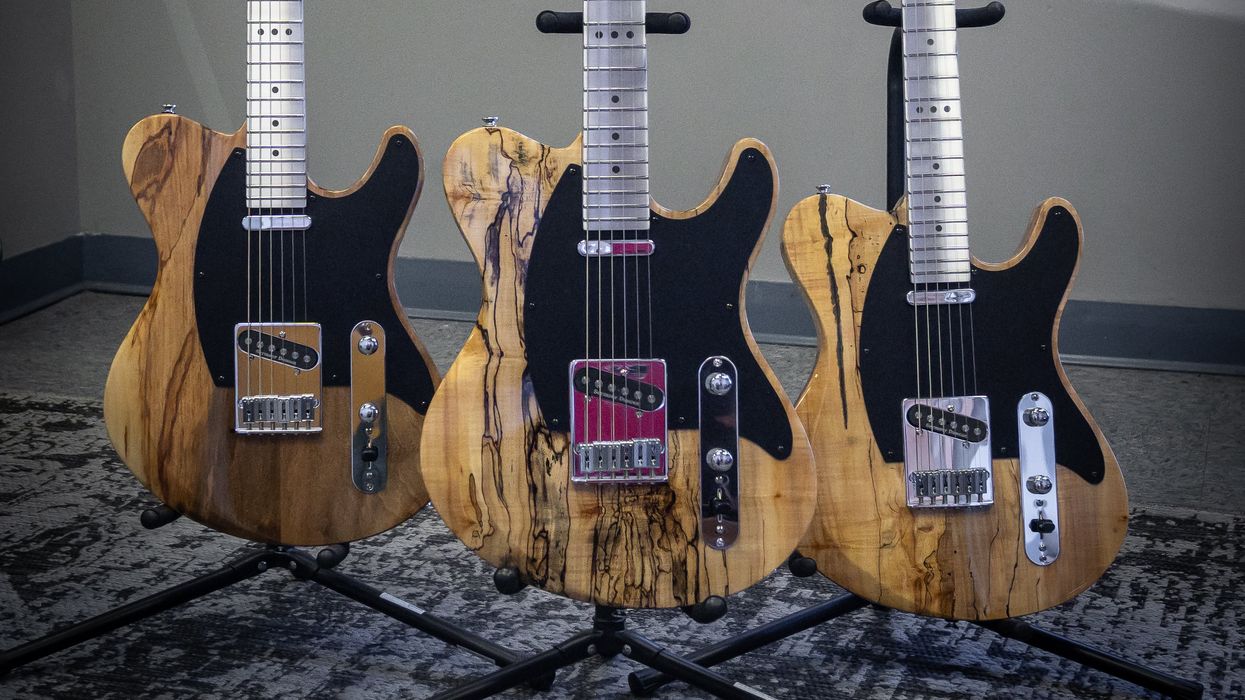
Aluminati Guitar Company, a pioneer in sustainable guitar manufacturing, is proud to unveil the Floodcaster— a guitar with a story to tell. Built from wood reclaimed from the aftermath of Hurricane Helene’s catastrophic flooding in Asheville, these instruments blend history, innovation, and sustainability in a way never before seen in the industry.
When floodwaters surged through Asheville, homes, businesses, and studios were left devastated. Seeking to give new purpose to damaged materials, Aluminati salvaged enough reclaimed wood for a charitable run of guitars. Paired with Aluminati’s precision-engineered aluminum necks, the Floodcaster is a guitar that not only delivers exceptional performance but also tells the story of Asheville’s resilient community.
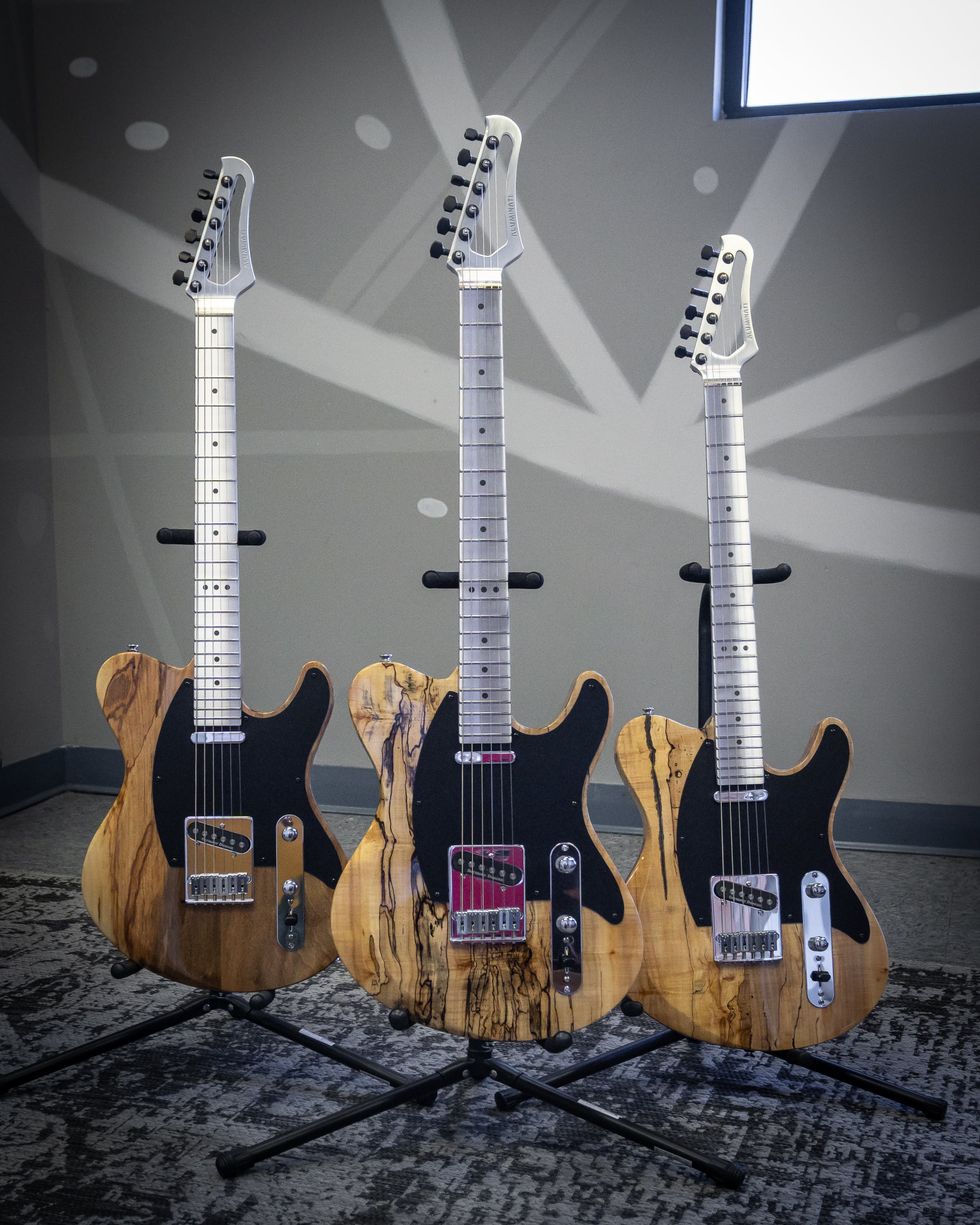
“Every piece of wood used in the Floodcaster Model has a story, and we’re turning that story into an instrument that players will cherish,” says Aluminati CEO, James Little.
Featuring unmatched sustain, clarity, and durability, the Floodcaster is built for modern players who value both performance and craftsmanship. With reclaimed materials giving each guitar a distinctive character, no two Floodcasters are exactly alike.
Giving Back to WNC
A portion of the proceeds from each Floodcaster sold will go directly to relief efforts in Western North Carolina, supporting communities still recovering from the devastation of Hurricane Helene. By putting these materials back to work, Aluminati is not only creating exceptional instruments but also helping rebuild what was lost.
After the initial release, Aluminati plans to partner with high-profile guitarists who will play and sign a select number of Floodcasters. These one-of-a-kind instruments will be sold at auction, with a portion of proceeds going directly to WNC relief efforts.
The first run of Aluminati Floodcasters will be available for purchase at $6,999 on Aluminati’s website, September 27th, 2025.
Floodcaster Specs:
- Aluminati HollowCore™ Aluminum Neck
- Aluminum Fretboard
- Sperzel Locking Tuners
- Jescar Jumbo Stainless Steel Frets
- Bolt-on Brass Nut
- Seymour Duncan ¼ Pounder Tele Pickups
- 3-way Toggle with a reverse control plate for volume swells.
- Gotoh Modern Tele Bridge
- Reclaimed Spalted Maple Body
- 25.5” Scale with 22 Frets
- 12” Radius
- D Shape neck
- Hand Wired and Finished
- 250k Bourne Pots
Selling your gear to make room for more? Reverb Wallet grants exclusive perks to sellers keeping their earnings on Reverb

Hot on the heels of the recent announcement that the marketplace was reducing its fees for sellers – down 3% to just 5% now – and adding a slew of smarter selling features, Reverb is continuing its innovative streak with a new Wallet experience.
Principally, sellers can now get even more value for their music gear by keeping their earnings from sales in their Reverb Wallet, and consequently take advantage of a 1% cashback bonus, faster earnings and future access to “exclusive perks that can help them fund their new sound faster”.
So, essentially at its core, Reverb Wallet offers sellers an alternative to cash for their gear sales, and the option to boost their earnings if keeping them within the Reverb ecosystem – certainly good news for sellers looking to shift gear to make space for more in their collection.
“One of the most important parts of music making is trying out new sounds,” says Reverb’s Chief Technology Officer, Jason Wain.
“Whether you’re upgrading from an Epiphone Les Paul to a Gibson, or starting a new project that needs the dreamy tone of a Roland Juno rather than the gritty sound of the Moog Grandmother, we want to make that journey as easy as possible.
“With Reverb Wallet, players get access to more gear when they turn their old guitars, synths, pedals, and other instruments into higher earnings that help them refresh their rig.”
Reverb says its new Wallet feature is backed by a “trusted and regulated payments platform”, and will see users granted access to “exclusive perks over the coming months”.
In terms of how Reverb Wallet works in practice, sellers can opt in by visiting “Shop Settings”, and selecting “Reverb Wallet” in the payment settings section on the “Policies” page.
The slew of new features in quick succession follows Reverb’s recent return to independence for the first time since 2019 after being sold by marketplace giant Etsy.
The sale was made possible by two investors: Creator Partners, also an investor in BMI, SoundCloud, Color Studios and Mogul; and Servco, which owns a majority stake in Fender.
Learn more about Reverb Wallet at Reverb.
The post Selling your gear to make room for more? Reverb Wallet grants exclusive perks to sellers keeping their earnings on Reverb appeared first on Guitar.com | All Things Guitar.
EarthQuaker Devices Announces the Barrows Fuzz Attacker
Barrows pays homage to the iconic MKII circuit while adding modern refinements that would make even the most discerning vintage purist weep tears of harmonic joy. At its heart, Barrows features a trio of carefully matched germanium transistors nestled within finely tuned circuitry that has been lovingly coaxed to produce everything from light, singing distortion to crushing fuzz tones with nearly infinite harmonic-rich sustain.
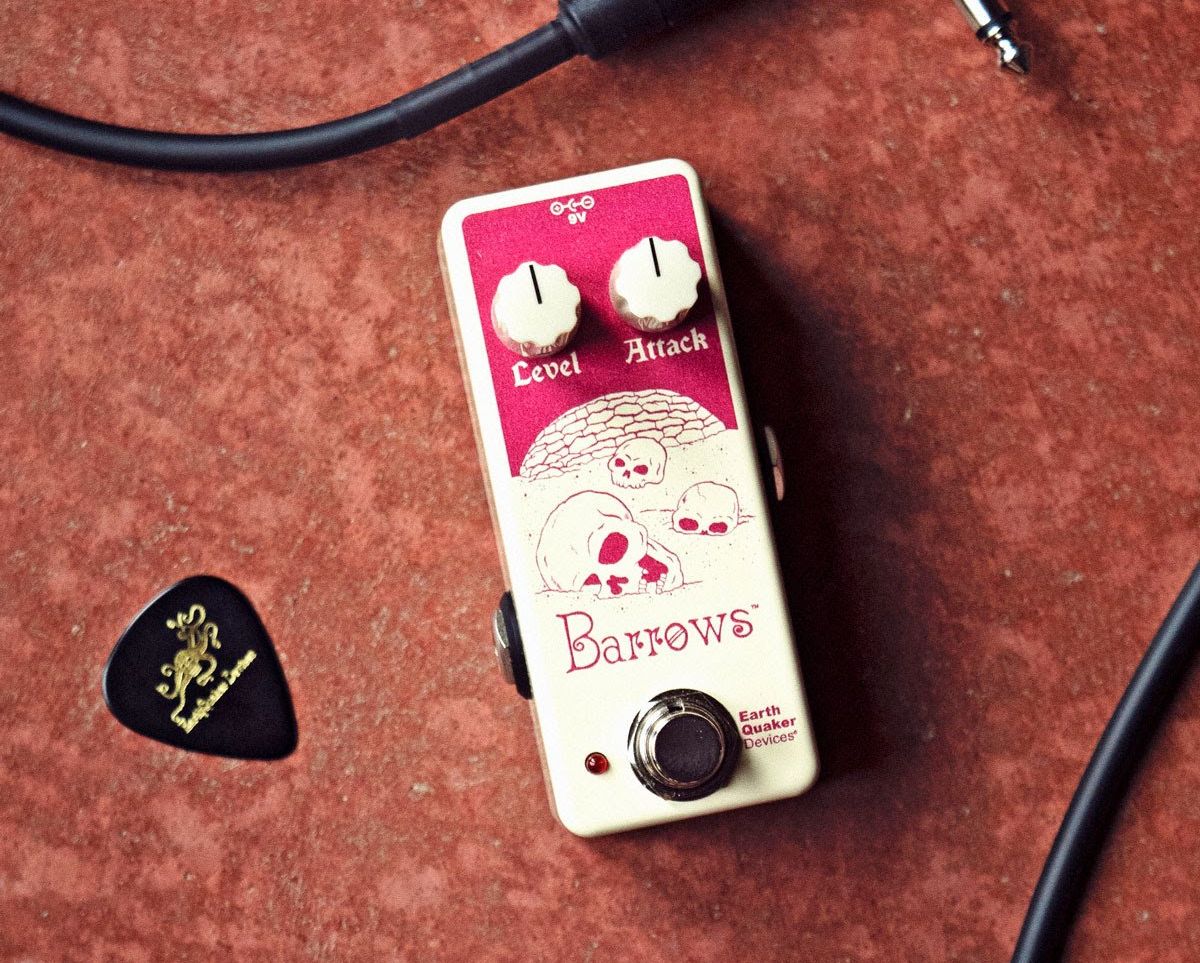
The original MKII circuit was the secret weapon behind some of the most crushing riffs ever committed to tape. From dawn-of-metal caveman dirges to the wall-of-sound symphonies conjured by the highest tiers of shoegaze sorcerers, this legendary topology has been the foundation of countless sonic monuments. Now, with Barrows, you can channel that same lightning-in-a-bottle magic while enjoying the reliability and versatility that modern craftsmanship provides.
At its heart, Barrows features a trio of carefully matched germanium transistors nestled within finely tuned circuitry that has been lovingly coaxed to produce everything from light, singing distortion to crushing fuzz tones with nearly infinite harmonic-rich sustain. This isn’t just another fuzz box – it’s a portal to the fabled tones that have haunted the dreams of fuzz fanatics for decades.
Barrows delivers the signature cutting mid-focused tones with plenty of low-end authority and brilliant top-end grind that made the original MKII a studio legend. But unlike its temperamental ancestors, Barrows includes several modern upgrades that transform it from a vintage curiosity into a contemporary powerhouse.
The phase-corrected and buffered output ensures it plays nice with other pedals down the line, while the increased output volume and wide range of fuzz tones make it a versatile sonic weapon. All this power is packed into a compact footprint that saves precious real estate on your pedalboard, because every square inch matters when you’re building your sonic arsenal.
Gone are the days of finicky positive ground power requirements and battery-only operation. Barrows runs on standard 9V power supplies, making it compatible with any common pedalboard power source. The true bypass switching ensures your signal remains pristine when the pedal is disengaged, while the MKII circuit works its germanium magic when called upon.
Each Barrows is lovingly assembled by shrimply the best helmspeople (and one obedient robot) on the high seas of Akron, Ohio, USA.
Tech Specs:
- Vintage three-transistor germanium fuzz circuit that is based on the Tone Bender MkII.
- Cutting, mid-range focused tones with loads of sustain and volume.
- Very responsive to playing dynamics and guitar volume control.
- Small form factor will fit on even the most cramped pedal boards.
- Mechanical true bypass switching
- Current Draw: 10 ma
- Input Impedance: 50 kΩ
- Output Impedance: <10 kΩ
- Limited lifetime warranty
- Retail Price: $129.00
BOSS Announces XS-100 and XS-1 Poly Shifter Pedals
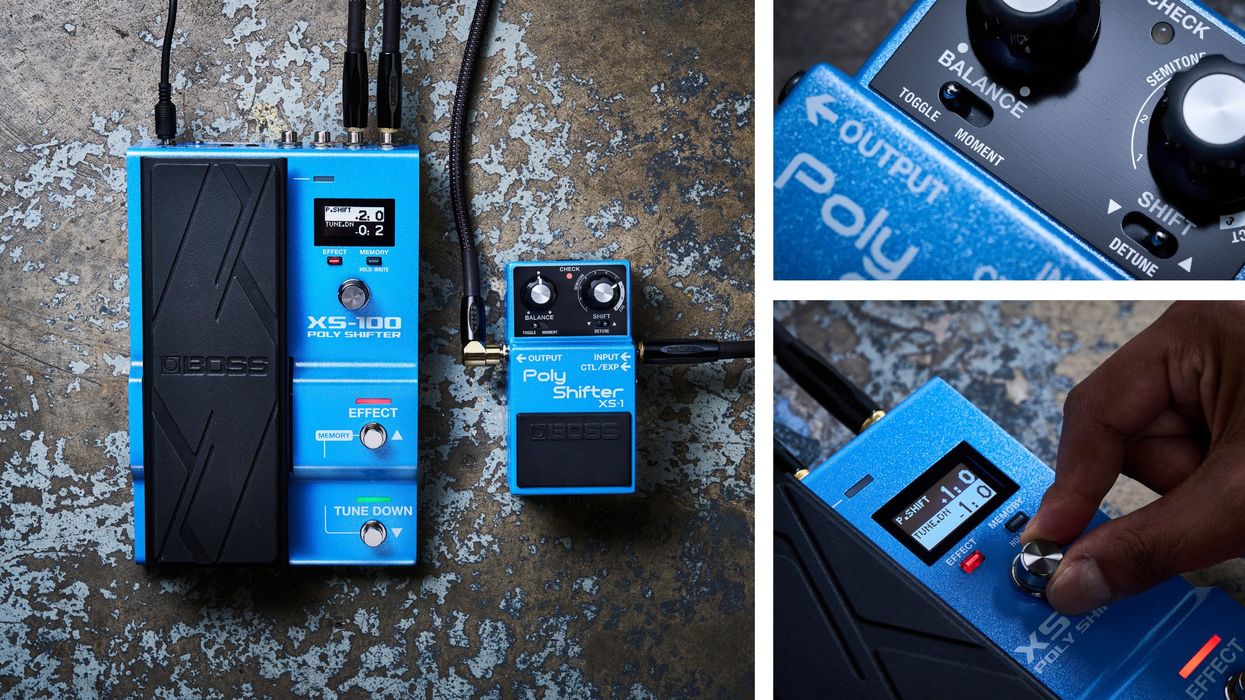
BOSS announces the XS-100 and XS-1 Poly Shifter products, two advanced pitch-shifting effects for guitar, bass, and other instruments. The XS-100 is a pitch-shifting workstation with a massive eight-octave range, real-time pitch control via an onboard pedal and footswitches, and versatile connectivity to interface with other gear. The XS-1 distills the core XS-100 features into the famous BOSS compact pedal format, providing instant drop tunings, capo simulations, octave effects, and linear pitch control with an optional expression pedal.
In developing the XS series, BOSS engineers pioneered new methods to advance real-time pitch shifting and eliminate the tonal artifacts common in conventional designs. Powered by finely tuned algorithms and a specially selected DSP platform, the XS series provides balanced polyphonic performance that feels natural and musical across all playing styles, pickup positions, and pedal setups. The attack and tonal character are fully preserved, and even complex chords and sustained lead tones—typically a challenge for pitch shifters—are reproduced with stunning clarity.
XS-100 Poly Shifter
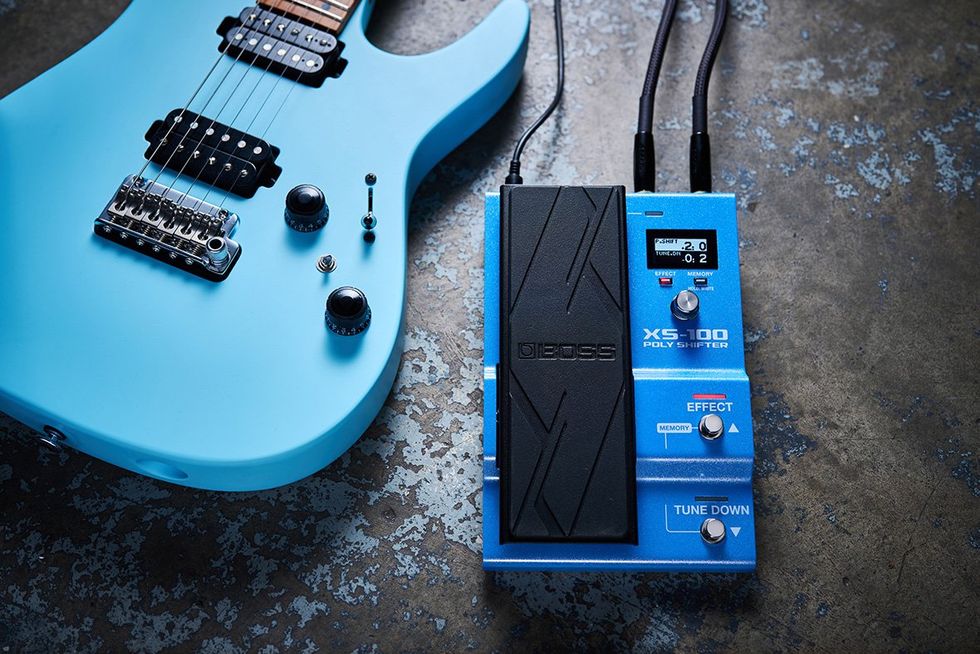
The XS-100 is a powerhouse expression machine that will transform how guitarists and bassists perform with pitch. An onboard pedal provides linear control of four octaves up or down, and independent pitch-change speeds for each pedal direction enable motor revving tones and other interesting effects. At the end of the pedal’s travel, an integrated toe switch can introduce momentary pitch jumps with adjustable range and rise/fall time. Two footswitches are also available to bypass the pedal shift and quickly retune an instrument at fixed semitone steps across eight octaves.
XS-100 users can customize the pedal’s range for different songs or techniques and fine-tune the response curve to suit different playing styles. In addition, the toe switch and footswitches can be reassigned to alternate functions. With 30 onboard memories, players can instantly recall favorite setups during live sets or studio sessions.
The XS-100 supports up to two external footswitches or an expression pedal, expanding the real-time control options. MIDI I/O opens the door to more advanced applications, from external MIDI control to sending MIDI commands with the pedal and footswitches. A secondary output mirrors the input signal, providing parallel routing flexibility for sophisticated rigs.
XS-1 Poly Shifter
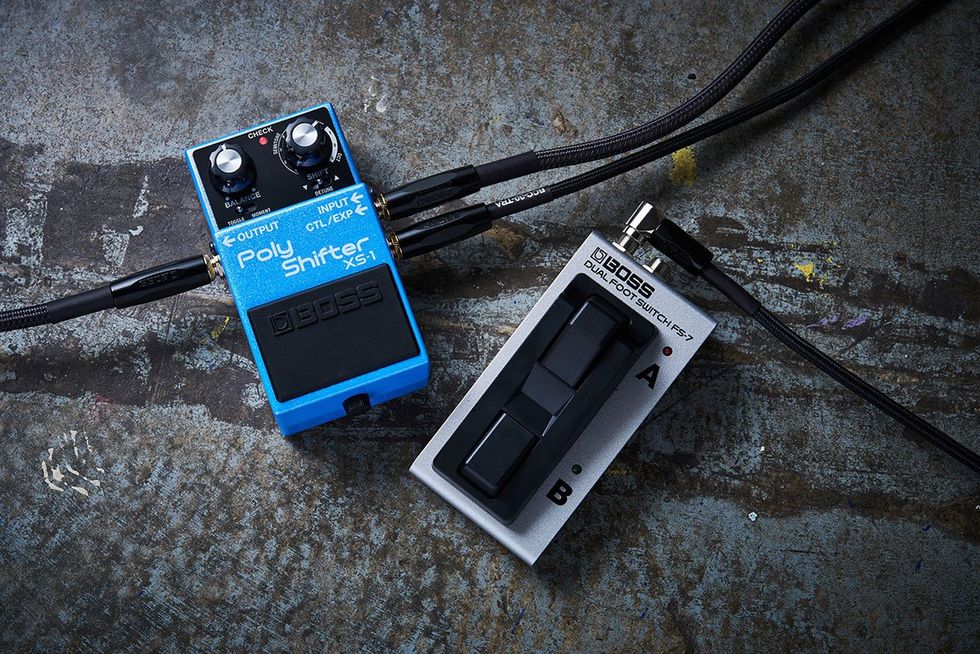
The XS-1 Poly Shifter delivers instant retuning in a convenient pedalboard-friendly footprint, making tuning changes fast, fluid, and seamless. Users can authentically perform songs in drop tunings, change keys to suit a vocalist’s range, play with unique octave-shifted sounds, and more.
Offering a range of +/- seven semitones and three octaves up or down, the XS-1 adapts to virtually any musical need. The intuitive interface features a dedicated Balance knob for adjusting the mix between the direct and effect sound. Turning the knob to effect-only allows for full retuning, while blending in the direct sound can create 12-string effects, parallel guitar/bass sounds, and unexplored sonic colors. There’s also a Detune mode to produce evocative doubling effects with high-definition tone.
The XS-1 provides many control options for different applications. The pedal switch can be assigned for standard on/off or momentary operation, and up to two external footswitches can be connected for fast access to alternate tuning modes with the user’s preferred Balance settings. Alternatively, an external expression pedal can be used to create dynamic pitch-bending effects for dramatic, ear-turning shifts.
Availability & Pricing
The BOSS XS-100 and XS-1 will be available in October 2025 for $349.99 and $199.99, respectively.
For the full press kit (available in several languages), including hi-res images, specs, and more, click here.
To learn more about the XS-100 and XS-1 Poly Shifter pedals, visit www.boss.info.
*USD Price at the time of publishing.
“Fender increased prices to offset higher costs from tariffs”: Report reveals how Fender is tackling tariffs and a “weaker macroeconomic environment”

President Donald Trump enacted hefty tariffs on the import of goods into the United States from countries around the world earlier this year, and they’re continuing to have a heavy impact on guitar manufacturers, including Fender.
Instrument and gear brands have been continually speaking out about the impact of these high tariffs on the guitar trade. Fender’s Executive Vice President Of Product, Justin Norvell, even travelled to Washington earlier this year in an attempt to mitigate the “devastating” impact of the global tariffs alongside industry figures including NAMM’s John Mlynczak and Gibson’s Erin Salmon.
According to a new report from financial information and analytics expert S&P Global [via Guitar World], Fender increased prices throughout the first half of the year to offset higher costs from tariffs, “especially from China, which makes up 40 percent of purchases (half of which enter the US).”
The report further claims that the Big F implemented a five percent price increase in July across its entire portfolio to tough out the financial challenges of the enacted tariffs, but also, it acknowledges the impact of a weaker economy on the business, and explains how sell-in habits – the sales from manufacturers and dealers – affect the brand.
The report states, “Sell-in has exceeded our expectations for retail partners like Guitar Center, SweetWater, and Amazon, as higher-income consumers continue to value the Fender brand.”
Despite this, it also notes: “Nonetheless, volumes continue to decline due to lower consumer discretionary spending, which we expect will continue throughout the remainder of the year. For example, smaller locally owned US dealers continue to tightly manage inventory amid a weaker macroeconomic environment as consumers trade down to the second-hand market or defer discretionary spending.”
S&P Global also claims that Fender is having some success in regards to its entry-level trade; it believes that Fender is “gaining market share” in low-end guitars due to competitor brands allegedly reducing “imports of low-end guitars from China due to tariff headwinds.”
In summary, S&P states: “In 2026, we expect improving volume trends from new innovations, though we continue to expect subdued consumer sentiment resulting in minimal revenue growth. We expect dealers will remain cautious on increasing inventory levels because of a weak macroeconomic backdrop with lower discretionary spending on big-ticket items like guitars.”
It continues, “We expect management will continue to exercise prudent cost management and limit marketing spending and compensation costs to offset its lower gross profit given a weaker macroeconomic environment.”
View the full product lineup from Fender, or find out more on how Fender and other guitar brands joined forces to try and mitigate the impact of high tariffs.
The post “Fender increased prices to offset higher costs from tariffs”: Report reveals how Fender is tackling tariffs and a “weaker macroeconomic environment” appeared first on Guitar.com | All Things Guitar.
Darkglass Electronics Launches “Entropia”
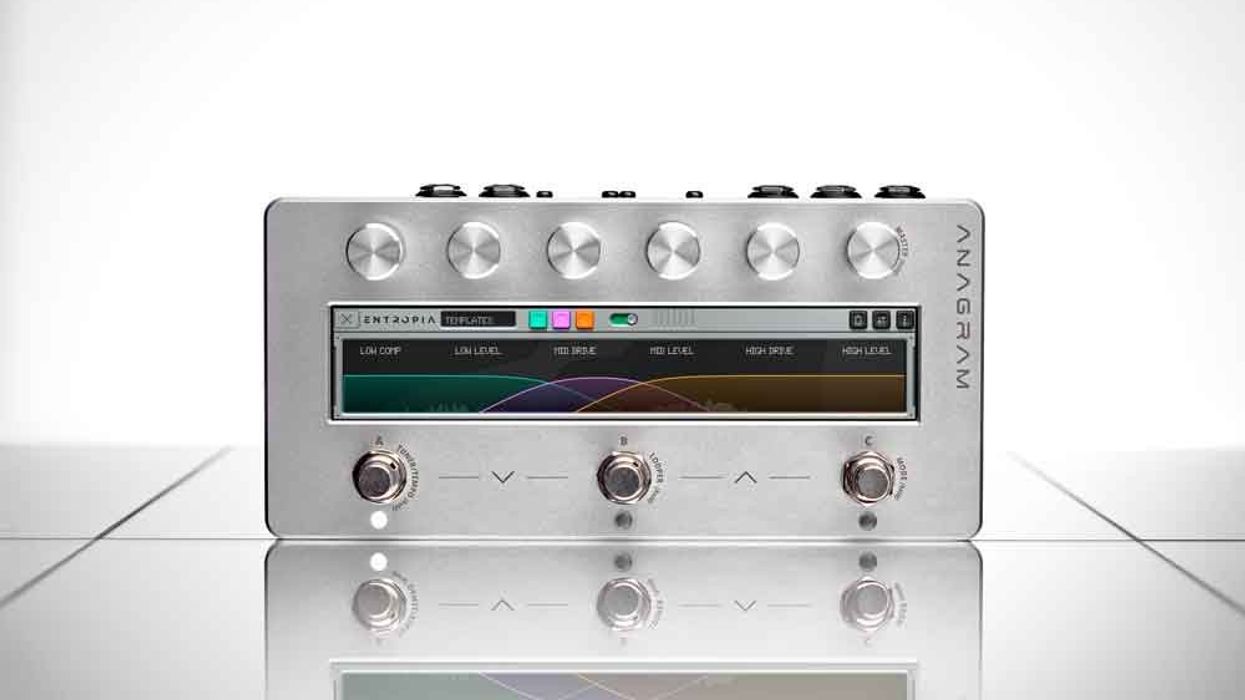
Darkglass Electronics, a global leader in high-end bass amplification and effects, proudly announces the release of Entropia, a groundbreaking multiband compression and distortion plugin designed exclusively for the Anagram platform.
Inspired by the concept of entropy, the natural progression from order to disorder, Entropia empowers musicians and producers to deconstruct and reshape sound with surgical precision. Featuring three fully independent bands (low, mid, and high), Entropia offers unparalleled control over tone sculpting, enabling users to bend, break, and rebuild their sonic landscape.
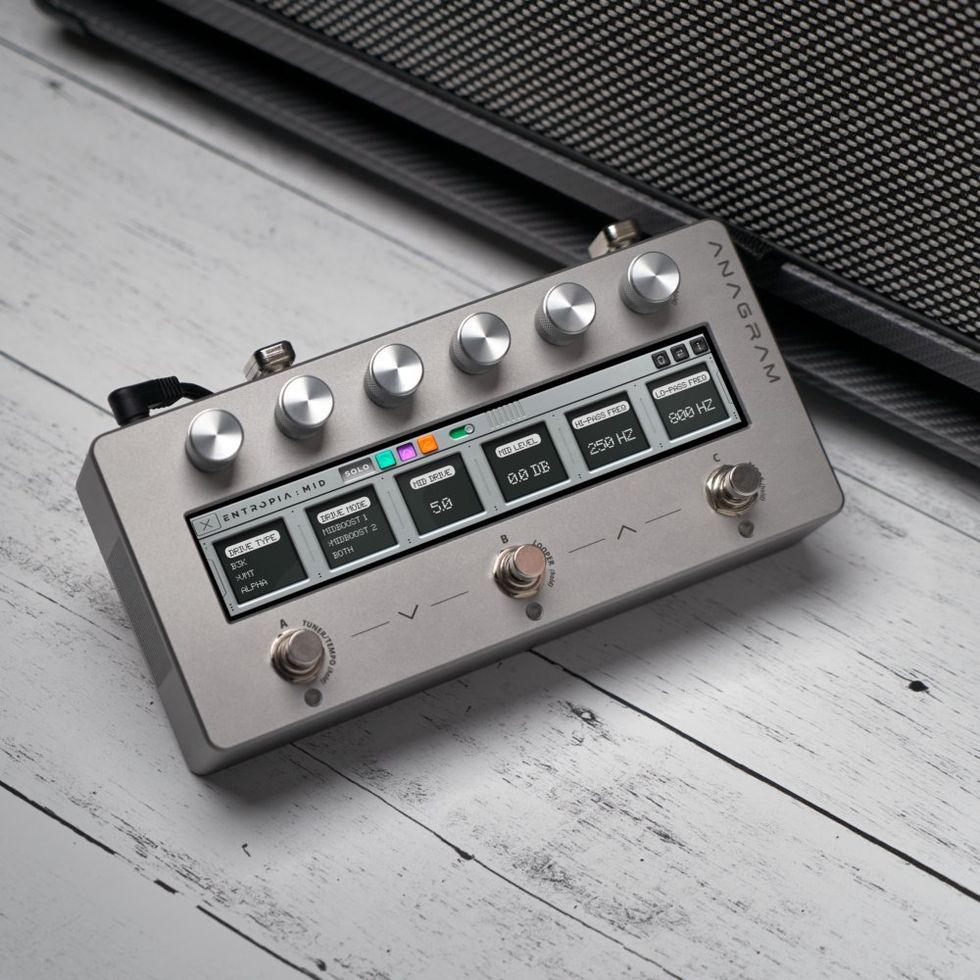
“With Entropia, we open a new door,” said Marcos Barilatti, Director Manager at Darkglass Electronics. “This plugin marks a pivotal step toward a new generation of modular tools for the Anagram platform. It expands the creative possibilities of what Anagram can achieve.”
Entropia introduces a powerful new feature called Templates, expertly curated presets that serve as intuitive starting points for tone creation. These templates allow users to explore the plugin’s full potential with ease, making it accessible to both seasoned professionals and curious newcomers. Unlike traditional distortion plugins that overwhelm the signal, Entropia offers a refined approach to sonic chaos. It’s not just compression and distortion, it’s the artful distribution of entropy, giving users the ability to shape sound with intention and clarity.
Availability
Entropia will be available for download via the Darkglass Suite app starting September 25, 2025. Please note: Anagram pedals will not update automatically. To install Entropia, users must connect their pedal to the desktop Suite and manually initiate the update.
For more information on Entropia please visit www.darkglass.com
DOD Unleashes the Overdrive Preamp 250-X – A New Chapter in a Legendary Pedal’s Story
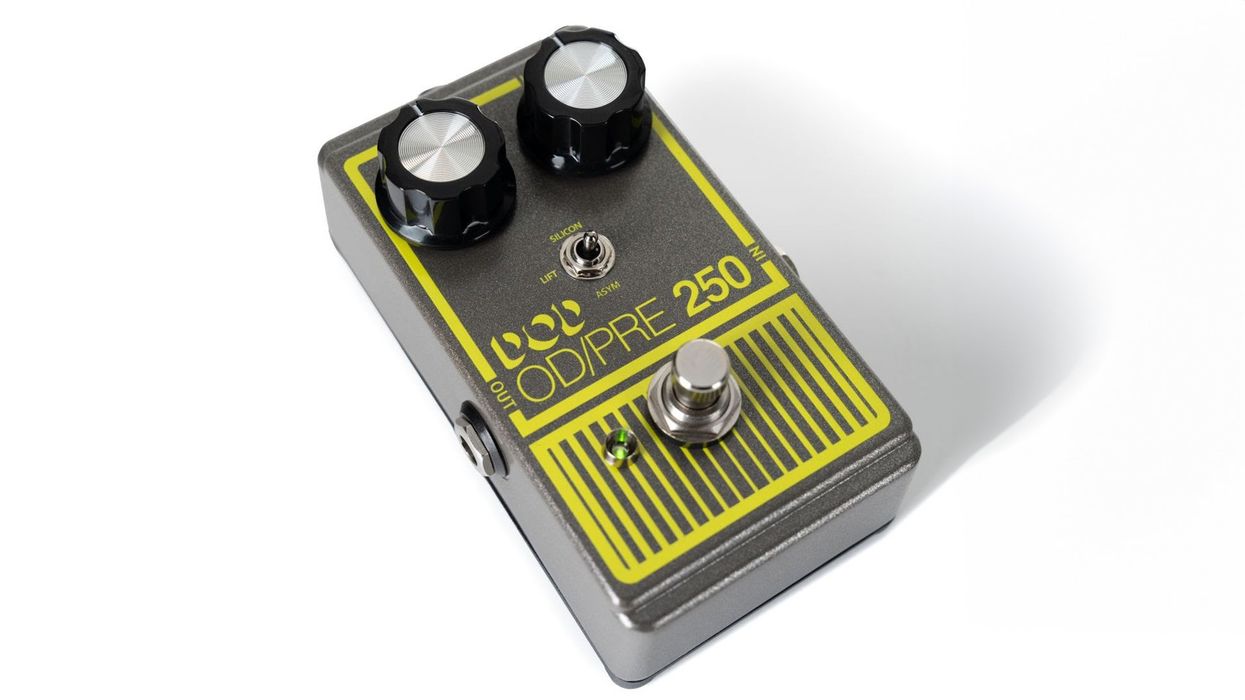
DOD today announces the release of the Overdrive Preamp 250-X, the 10th iteration of its legendary OD250 pedal. Available worldwide through local and online retailers, the 250-X delivers unmatched tonal versatility for players of all skill levels and musical styles. With three distinct distortion modes and modern refinements, the 250-X offers a fresh take on their time-tested classic at a new price point that strives to outperform its contemporaries in its category.
Inspired by the limited-edition DOD OD250-50th Anniversary model released last year, the 250-X (X representing the 10th iteration) offers the same three-position toggle switch function but in an imported, mass-produced model, at a more affordable price.
Operation is straightforward and intuitive. At its core, the 250-X retains the same Gain and Level control values and tapers as the original OD250, preserving the familiar feeling and response that players know and love. The three-position toggle switch expands its tonal range, offers Silicon symmetrical clipping for that iconic 250 sound, ASYM asymmetrical clipping for even-harmonic distortion, and LIFT mode, which removes diode clipping entirely from the signal path for a clean boost at moderate levels or a dirty boost at high levels as it drives the vintage-style LM741 op amp.
Built with an aluminum chassis and weighing in at only 8 ounces (250 grams), construction features true hard-wire bypass, modern 9V DC power input, and +18V tolerant circuitry. With ¼” connections for input and output, the pedal is ready for both stage and studio use making it the most versatile 250 to date.
For more information on the DOD Overdrive Preamp 250-X, visit www.digitech.com.
STREET: $119.99 USD
Heritage Guitars’ Standard II Collection adds “meaningful refinements” to its original Standard Series

[Editor’s note: Heritage Guitars and Guitar.com are both part of the Caldecott Music Group.]
Heritage Guitars has unveiled its Standard II Collection, described as a refinement of its original Standard Series, and it’s kicking things off with the newly updated H-150.
The launch continues Heritage’s 40th anniversary celebrations, with 2025 continuing to be a “landmark year” for the brand. So far, Heritage has also notably debuted the Custom Shop H-717 archtop and the Ascent Collection: a line of accessible instruments designed to bring Heritage’s craftsmanship to a wider audience.
Marking the first model in the Standard II collection, the refreshed H-150 introduces several key enhancements in construction, tone, and versatility. It offers an updated headstock with a new veneer featuring the ‘Heritage’ logo, and its body is crafted from genuine mahogany with weight relief, offering greater comfort without compromising on tone.
It has a ’60s neck profile, which is slim for ample grip with a vintage-inspired feel, and it also comes in brand-new finishes including Wine Red, Bourbon Burst, and Chestnut Burst, alongside existing favourites Dirty Lemon Burst and Ebony.
 Credit: Heritage Guitars
Credit: Heritage Guitars
Further diving into tone and electronics, the Standard II H-150 is fitted with new Heritage Custom Shop 225 Standard Humbuckers – designed and wound in-house, and offering a “broad and expressive” tonal range. Built with 42 AWG plain enamel wire (neck) or 43 AWG poly wire (bridge) on Butyrate unpotted bobbins, and 2.5” roughcast Alnico 5 magnets, they feature potted covers to minimise unwanted feedback at higher volumes.
The model is also equipped with series/parallel switching via push/pull tone pots for tonal flexibility, capturing the brightness and clarity of a “single-coil” voice without the volume loss of traditional coil-splitting.
Speaking of the new series, Heritage Guitars adds: “With the Standard II Collection, Heritage Guitars reaffirms its commitment to continual improvement and refining every detail to deliver meaningful upgrades for today’s players, while staying true to its American-made legacy.”
The Standard II H-150 is priced at $2,599. To find out more or view full specifications, head over to Heritage Guitars.
The post Heritage Guitars’ Standard II Collection adds “meaningful refinements” to its original Standard Series appeared first on Guitar.com | All Things Guitar.
Judge orders Gibson’s damages in Dean legal case upped from $1 to $168,000
![Headstock of a Dean guitar [main image], and the headstock of a Gibson guitar [inset]](https://guitar.com/wp-content/uploads/2025/09/Dean-Gibson-new-hero@2000x1500.jpg)
Back in March 2025, Gibson triumphed for a second time in its legal battle against Dean, with the latter having been found to have infringed on Gibson’s trademarks for the Flying V, Explorer and SG. However, that victory was tempered somewhat by the jury’s recommendation that Gibson be awarded just $1 in damages.
Now however, the judge in the case has increased this award, ruling that Dean’s parent company Armadillo Distribution Enterprises Inc, will have to pay Gibson just over $168,000 for the infringement, which is to be taken in disgorgement of profits earned through infringement.
In legal speak, disgorgement refers to the relinquishing or forfeiture of unlawfully obtained profits toward either the state, or in this case, to the party harmed, Gibson.
The original figure was so low because the jury felt that Gibson had waited too long to protect its trademark rights – Dean had been making guitars using the Flying V and Explorer body shapes since the 1970s, but Gibson didn’t take action against them for decades.
Now however, US District Judge Amos L Mazzant – who presided over the case – has decided that the jury’s recommendation is insufficient given the profits made by Armadillo over the period from use of the infringing shapes, and increased the damages to $168,399
Mazzant had the option to treble the damages or award Gibson statutory damages, but he declined to do so as he felt that any further financial punishment for Dean would be “punitive”.
“By requiring Armadillo to disgorge the profits it earned through infringement, the Court places Gibson in roughly the same position as it would have been had the infringement never occurred,” Judge Mazzant wrote in his latest opinion handed down on Monday (22 September).
“Here, statutory damages are unwarranted,” Judge Mazzant said in the ruling handed down on Monday. “The court already determined that disgorgement and injunctive relief are the proper remedy based on the equities of this case and any additional monetary award would be punitive.”
“Also, awarding statutory damages would be duplicative of the disgorgement award.”
The case wasn’t a total loss for Dean/Armadillo, however. While the brand was found to have infringed on the body shape trademarks for the Flying V, Explorer and SG – as well as the ‘Hummingbird’ and ‘Flying V’ wordmarks – but was found to have not infringed on either the ‘Dove Wing’ headstock shape or the ES body shape. In fact the jury even recommended that the ES trademark should be cancelled as it is generic.
In his latest opinion Judge Mazzant declines to elaborate further on this, though it could end up being a hugely impactful part of the case. He also neither accepted or denied Gibson’s request for Armadillo to cover the brand’s legal fees – both of these will be addressed in the final judgement on the case.
However, the injunction handed down now permanently bars Armadillo and Dean from making, advertising or selling products which infringe Gibson’s trademarks. Counsel for both Gibson and Armadillo have not commented on the matter at this time.
Brief history of Gibson vs. Dean
The legal battle between Gibson and Dean goes back to 2019, when Gibson accused Dean’s parent company Armadillo of trademark infringement, trademark counterfeiting, unfair competition and trademark dilution.
Armadillo subsequently launched counterclaims, saying a number of other guitar companies have been selling products with strong visual similarities to Gibson’s designs for decades. It argued, therefore, that Gibson’s trademarks should be cancelled for genericness.
But in 2022, Dean and Armadillo were found guilty of trademark infringement and counterfeiting pertaining to Gibson’s Flying V, Explorer, SG and Hummingbird shapes. At the same time, the jury found that Gibson had delayed in asserting its trademark rights for the Flying V and Explorer body shapes, and the Dove Wing headstock shape.
The case then went to the United States Court of Appeals for the Fifth Circuit, which in July 2024 ordered a new trial after finding that the district court had improperly excluded evidence.
However, after a second seven-day trial in March, Gibson once again triumphed – albeit in a more limited fashion than the first case. The jury found Dean had infringed on the Flying V, Explorer and SG – as well as the ‘Hummingbird’ and ‘Flying V’ wordmarks – but was found to have not infringed on either the ‘Dove Wing’ headstock shape or the ES body shape, and recommended the cancellation of the latter.
Guitar.com has reached out to both Gibson and Dean/Armadillo for comment on the latest ruling.
The post Judge orders Gibson’s damages in Dean legal case upped from $1 to $168,000 appeared first on Guitar.com | All Things Guitar.
Noel Gallagher’s 1960 Gibson ES-355, which Liam Gallagher destroyed right before Oasis’s breakup, is headed to auction – and could fetch up to £500k

There are certain instruments which hold an unassailable place in music history. And Noel Gallagher’s 1960 Cherry Red Gibson ES-355 is one of them.
While Oasis are back now stronger than ever – and in the midst of a world tour, one of the most highly anticipated in history – the Gallagher brothers have had to fight through their share of differences to get to this point.
It was inevitable that the band’s breakup in 2009 would be climactic, and ultimately saw a fight break out between Liam and Noel backstage at the Rock en Seine festival in Paris. The bust-up was not without collateral, either, as Liam grabbed Noel’s ES-355 and swung it “like an axe”, causing the damage which can be seen on the instrument today.
This guitar played a big part in the story of Oasis’s contentious breakup, so now that it’s headed to the auction block, it’s understandable experts are predicting such a high sell price: £250,000 – £500,000, to be precise.
According to PropstoreAuction – the auction house hosting the sale – Liam chose this guitar to swing around because he knew it was one of Noel’s favourites. “So then he leaves and goes to his own dressing room and picks up a guitar,” Noel explained in 2011. “He comes back in and he starts throwing it around like an axe.”
Noel later announced he was leaving Oasis, saying he could no longer work with Liam, and the band subsequently split.
 Credit: PropstoreAuction
Credit: PropstoreAuction
Aside from its big part in Oasis’s 2009 breakup, the ES-355 was used by Noel and Gem Archer during Oasis’s Dig Out Your Soul tour in 2008, as well as extensively in the studio. Archer also played the guitar during the band’s performance of Don’t Look Back in Anger at Wembley Arena in 2008, and Noel played it during an acoustic performance at Koko Club in Camden on 2 November, 2006.
Online bidding for the guitar is open now, with a minimum starting bid required of £125,000. The auction will end on Thursday, 23 October.
Noel Gallagher’s 1960 Cherry Red Gibson ES-355 is just one item in PropstoreAuction’s mega Music Memorabilia Live Auction. Other items headed to the auction block include:
- Noel Gallagher’s Takamine FP460SC acoustic used to record Wonderwall (Est. £200,000 – £400,000
- Lyrics handwritten by Jimi Hendrix for Straight Ahead (Est. £40,000 – £80,000)
- Slash’s 2019 Gibson Les Paul Appetite Burst “Prototype 2 of 2” (Est. £20,000 – £40,000)
- Trevor Horn’s Sarm West Studio 2 Solid State Logic SL 4048E+G Series Mixing Desk (Est. £100,000 – £200,000)
- Michael Jackson’s Smooth Criminal music video white fedora (Est. £40,000 – £80,000)
- Elvis Presley’s original pair of worn Grand Prix sunglasses (Est. £8,000 – £16,000)
“Propstore’s auction is a celebration of music history, with guitars that shaped the sound of a generation, handwritten lyrics that capture the first spark of legendary songs, and personal items that offer a glimpse into the lives of the world’s greatest music artists,” says Mark Hochman, Propstore’s Music Specialist.
“From John Lennon’s unmistakable glasses to Noel Gallagher’s iconic guitars, these are not just collectables; they’re cultural touchstones that have inspired millions. The Oasis online auction is a particular highlight, perfectly timed with the band’s return to the stage, and offering fans a once-in-a-lifetime chance to own a tangible piece of their enduring story.”
Learn more at PropstoreAuction.
The post Noel Gallagher’s 1960 Gibson ES-355, which Liam Gallagher destroyed right before Oasis’s breakup, is headed to auction – and could fetch up to £500k appeared first on Guitar.com | All Things Guitar.

